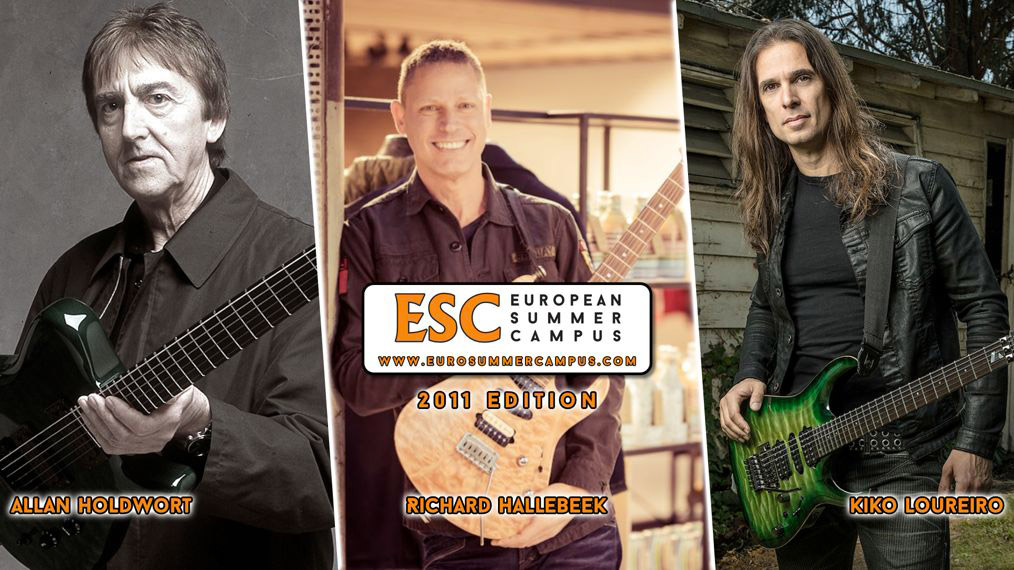The 2011 edition of the ESC (European Summer Campus) was the last edition before the 10-year break of the event. It took place in Syracuse, at the main hall of Palazzo Impellizzeri on the island of Ortigia. The event is now an unmissable event for those who want to deepen the musical language and meet great guitar legends in attendance. It was a memorable edition because one of the most important and innovative guitarists and composers in the history of the electric guitar accepted to come: the great Allan Holdsworth, unfortunately passed away on April 15th 2017. The other two guitarists invited, also from high artistic and cultural profile, were Kiko Loureiro (Brazil) and Richard Hallebeek (Netherlands).
Richard Hallebeek is a great fusion shredder with complex instrumentation, starting with the guitar: a Suhr Modern with a splendid alder body, two boosters (Xotic and TC), EBS MultiComp compressor, Providence Anadime chorus and a Boss DSD-3, all pumped up from a Randall V2 Archetype.
This instrumental organization also corresponds to a careful division of the didactic topics to be treated into four sections: creativity with scales, playing through changes, chords, playing outside.
The method for scales is to play them three notes per string in various combinations. Starting from a G major scale, Richard shows a 231 sequence (referring to the order in which the notes appear on the individual strings, not to the fingering) where the last two notes are played with a legato. This pursuit of peculiar intervals becomes more evident in the following demonstrations in which we also see a hybrid pick-finger technique to move to the upper strings and a choice of playing very wide scales, or “exploded”, in which the fingering 124 is exploited to the limits maximum (index-medium fingers distance of five or six frets!).
He recommends playing the major scales by permuting a random order, not necessarily starting from the root note to experiment with many variations and novelties.
To play outside, he first recommends trying a key one semitone above or below the “right” scale, then you can move on to diminished scales.
Kiko Loureiro is a well-rounded guitarist, coming from the historic band Angra and then established himself as a multifaceted soloist, capable of passing from metal to bossa nova with nonchalance, managing to maintain an identifiable soul both on the rhythms and in the solo parts. He is the author of educational material for the Brazilian and international market, made available to the ESC thanks to the collaboration with the Birdland Bookshop in Milan.
Its instrumentation is simpler than that of Hallebeek: Tagime Kiko Loureiro guitar with 27 frets pau marfim neck (greedy…), a Laa Custom overdrive, a Zoom G2.1KL multi-effect, the same delay of the Dutch, but a head Laney VH100R.
His didactic vision is more philosophical, less pragmatic and very much based on advice and anecdotes for the participants. He demonstrates an inhuman technique and speed along with a very deep knowledge of harmony and rhythm, which overall brings out a very interesting musical genius.
He recommends practicing triads and inversions for improvisation, horizontally and vertically, adding passing notes, eliminating others and inserting techniques such as string skipping and legate.
Allan Holdsworth, “the John Coltrane of the guitar” (Robben Ford), ” one of the most interesting guys on guitar on the planet” (Frank Zappa), reference point for guitar heroes such as John Petrucci, Yngwie Malmsteen, Shawn Lane and many others, is one of the key figures of the jazz-fusion guitar. Self-taught, he did not know how to read music, but he has always distinguished himself for an unlimited knowledge of scales and chords, modes and musical moods that are part of a very personal symbology a la Holdsworth. We know in fact that his scores do not present the traditional symbols to refer to the chords, but figures coined by him as × for the m7 and Ⓧ for the m(maj7). This is certainly due to his abstention from the usual teaching methods, which, even from the transcriptions alone, shows us an open and boundless mentality, with which he unhinges the cornerstones of the academy to reach heights worthy of divinities, to which we mortals do not will we ever aspire.
The unrepeatable sound of him is obtained above all thanks to his hands, for him the salient point of every sound, although then the instrumentation plays an important role. Legato and vibrato lever help in emulating classical instruments such as the violin and saxophone. In fact, we know that he is very inspired by Coltrane and the feeling is that of not listening to a guitarist, as the scales are difficult to recognize and are adapted to broaden or contrast the underlying harmony, making extensive use of chromatisms.
His axe is a Steinberger GL2TA-AH, accompanied by two Hughes & Kettner Switchblade amps, six Yamaha MagicStomp pedals, two Korg volume pedals, TC booster and MXR noise gate.
His chords are naturally on the verge of finger stretching, as he splits and twists classic positions to reach interesting intervals.
The scales he uses prefer a composition with three notes per string to facilitate the legato, plus this vision of the scales provides him with the genesis of chords, which avoid open forms. He only uses the hammer-on, avoiding the pull-off even in the descending phase.
It was an extraordinary experience for all present, thanks to the variety of guests and the topics covered in class. Participants were given the certificate of their respective level by the teachers themselves, with the participation of Andrea Quartarone, a highly respected guitarist and ESC organizer since 2006.
At the end of the event, the IGJ (International Guitar Jam) of the invited artists took place as usual.
ARTISTS

